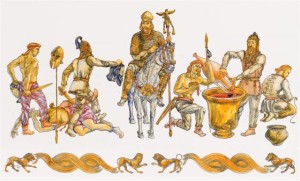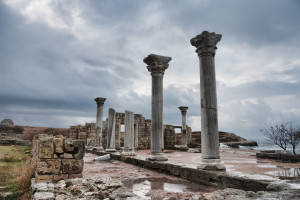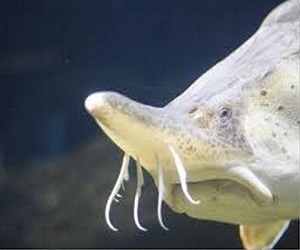Timeline of the History of Crimea
Important chronological events in the history of Crimea
1300-800 BC – Cimmerians, nomadic warrior people, lived on the banks of the Cimmerian Bosporus, modern Kerch Strait.
800 – 600 BC – In the ancient world the tribes of forest mountains of Crimea become known as “Tauris”.
600 – 300 BC – The Scythians, war nomads from the steppes of the northern Black Sea region and the Caucasus, invade the foothills of Crimea. They established their capital in Scythian Neapolis, modern day Simferopol.
513 BC – The unsuccessful campaign of Persian king Darius I against the Scythians destroyed freshwater sources and destroyed the land by burning trees and grass. They did not carry a single battle but did great damage to the ecology of the Crimean Peninsula.
400 – 200 BC – The low water levels on the north west of the Black Sea gave way to the Sea of Azov leaving the Crimean Peninsula in its present day form.
300 – 200 BC – Greek colonies appeared along the coast creating the Greek Bosporan Kingdom on the east of the peninsula. Their major city was Chersonesos, modern day Sevastopol. The Greeks never succeeded in conquering the entire peninsula. They placed their colonies in land suitable for agriculture. Scythians wanted access to the sea and tried to oust the Greeks. The Greeks in Chersoness asked for help from Pontic King Mithridates VI to repeal the Scythians and in a successful battle the Scythians were defeated. Chesoness became a Pontic colony.
100 BC – The Bosporian Kingdom was invaded by the Romans in the war against Mithridates VI. They established naval bases at Chersoness and in strategic locations along the coast. Christianity starts speading.
70s. n. e. – Romans built fortress on Cape Ai-Todor and the first road to Kherson, present day Sevastopol.
250 AD –Goths invaded Crimea and stormed Scythian’s fortress.
350 AD – Huns destroyed Goth kingdoms in Europe including Crimea, they destroyed the Scythian state and Greek Bosporus cities . The Huns looted and burned cities.
400 AD – Semi nomadic Bulgars arrived in the peninsula. Byzantium succeeded Rome and at the initiative of Emperor Justinian built several fortresses: Aluston (Alushta), Gorzouvites (gursuf) and several fortifications to protect allies.
500 – The Khazar Empire absorbed the Bulgars, then created the most powerful western steppe empire by creating trade routes between Europe and Asia. The Khazars took a significant portion of Crimea from the Byzantine Empire but later reached an agreement to repel the Arabs
600-1100 – Feudal relations led to the development of south western Crimea. Fortified settlements were built on the Cuesta Internal ridge forming “cave cities”. The largest of these is Mangup which dates back to the XII century. South western Crimea became an influential center of the Christian principality of Theodoro. Its population was a mix of Greeks, Bulgars, Kypchaks and Goths, among others who followed Orthodox Christianity.
900 – 1000 – Kievan Rus’, east Slavic tribes in Europe reigned from the Black Sea to the Baltic Sea. They established its capital in Kiev. Modern day Russians, Ukranians and Byelorussians consider Kievan Rus’ as their cultural inheritance. Kiev prince Vladimir reached an alliance with Byzantine Emperor Basil II.
1200 – The Venetian Geonese colonized the Crimean coast. They struggled for supremacy in the Black Sea.
1230 –Mongols arrived in the peninsula. Crimea became part of the Tatar Empire that extended from China in the east to Moscow in the west. They established their capital in Qirym (Krym).
1420-1466 AC – Founder of the dynasty of the Crimean khans, Hadji Devlet Giray, creates an independent state (1443), with its capital in Bakhchisarai. He encouraged transition to a settled population. The development of gardening and crafts, construction of temples and monasteries of Islam and Christianity flourished in this period. He reached a military alliance with the Polish-Lithuanian state.
1467-1515 AC – Mengli I Giray in military alliance with Moscow kingdom expands influence on the north and east of the Crimea.
1475 – Ottoman Turks captured Genoese fortress on the coast and the Principality of Theodoro in Southwest Crimea, creating the Crimean Khanate.
1500 – 1700 – Moscow raided the Crimean Khanate. Cossacks raided Turkish fortresses and Tartar settlements.
1768-1774 – Russian-Turkish war, which resulted in the Crimean Khanate proclaimed independent of Turkey, Kerch became a Russian city.
1783 – Crimea was absorbed by Russia and recognized the rights of the Russian nobility for all the noble families of the Khanate. Russia built the cities of Sevastopol as the center of the Russian Black Sea Fleet and Simferopol (1784) as the center of the Tauride province.
1787 – Journey to the Crimea Russian Empress Catherine II and Emperor Joseph of Austria-Hungary I – the most expensive tour of all time.
1787-1791. – Second Russian-Turkish War. Turkey recognized the annexation of Crimea by Russia.
1853-1856 – The Crimean War. Sevastopol becomes a place of heroic battles on land and sea: Russia struggles against England, France and the Kingdom of Sardinia.
1875 – The construction of the railway to the city of Sevastopol was completed and opened the vast Russian and European market for agricultural products, wines and confectionery. Business, trade and industry developed rapidly. The imperial family summer residences were built in Crimea.
1918-1921 – Crimea became the scene of fierce battles of the Civil War and the intervention of Imperial Germany ended the inclusion of Crimea to the Soviet Union (1922) with the formation of the Crimean Autonomous Soviet Socialist Republic within the Russian Federation.
1941-1944 – The Peninsula was not spared by the World War II. Crimea’s population fell by half and the city laid in ruins, the economy as in the rest of the Soviet Union had been destroyed. The Germans released Crimea in May 1944. Stalin deported ethnic nationalities such as Crimean Germans, Tartars, Bulgarians, Armenians and Greeks.
4-11 February 1945 – Crimean (Yalta) Conference of Heads of Government of the USSR, Stalin; USA, Roosevelt; and Great Britain, Churchill; defined the postwar world. The three countries adopted decisions on the division of Germany into zones of occupation and reparations, on the participation of the USSR in the war with Japan, the postwar system of international security and the establishment of the United Nations.
1954 – General Secretary of the Communist Party of the Soviet Union, Nikita Khrushchev, transferred Crimea from the jurisdiction of the Russian Federation under the jurisdiction of the Ukrainian Soviet Socialist Republic and becomes an area within Ukraine. The economy was gradually restored.
1970 – Rapid development of resorts and tourism. The development of heavy industry and chemicals in agriculture creates environmental problems.
1974 – U.S. President Richard Nixon visits Crimea in a meeting to start economic cooperation with the Soviet Union in the areas of airfields and highway construction as well as on the production of Pepsi Cola.
1991 – “Coup” in Moscow and arrest of President Gorvachev. The Soviet Union collapsed and Crimea became an autonomous republic within independent Ukraine.
Gradual return of the deported Tartar population to Crimea with the support of Turkey starts fears of a second revival of the Ottoman Empire.
2014 – The Ukrainian government of Viktor Yanukovich fell under a population revolt in Kiev. The Parliament of the Autonomous Republic of Crimea voted to secede from Ukraine and for its annexation to the Russian Federation.
Category: History



